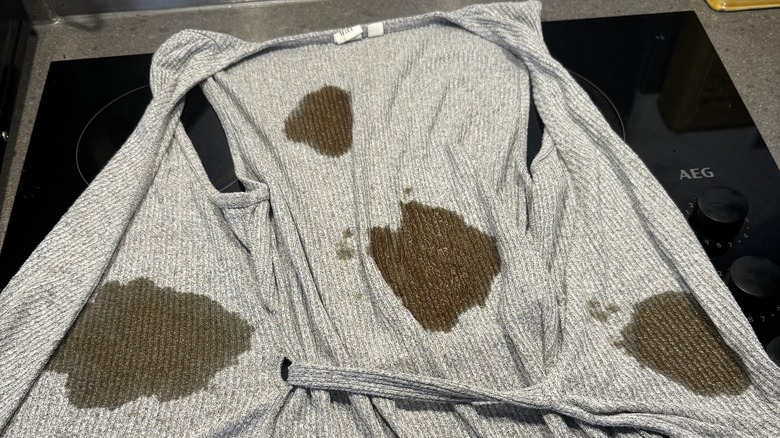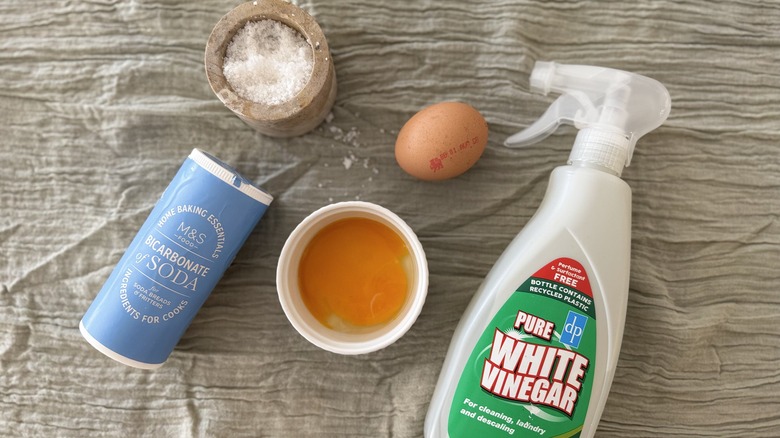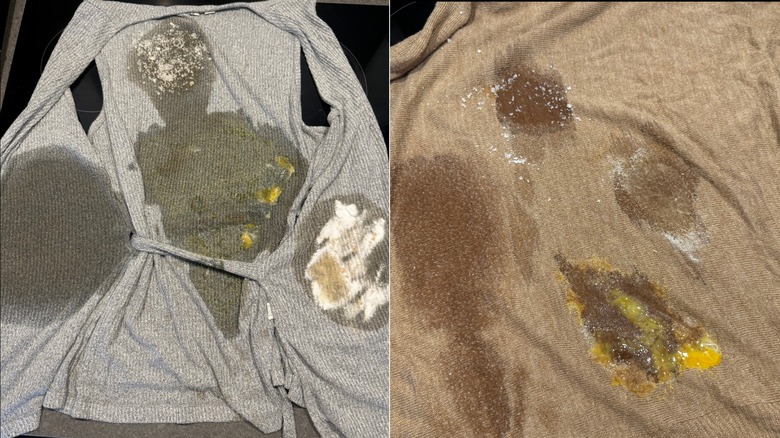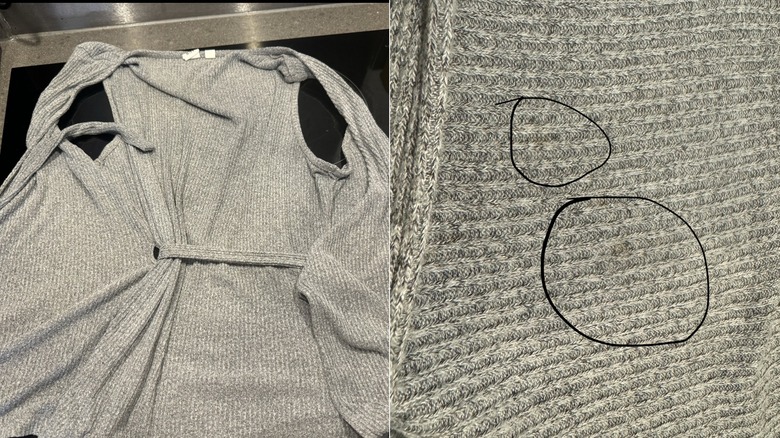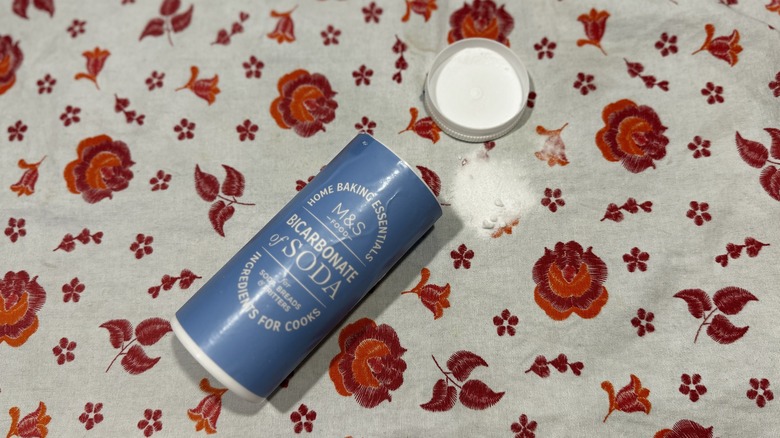Coffee Stain On Your Clothes? We Tested Common And Unexpected Ingredients To Clean It
It's unfair that at our most hurried, drowsy, and uncoordinated is usually when we need coffee, which inevitably leads to spills on our clothes. More unfortunate still is that coffee is made up of acid and oils and has a deep brown color that can show through on most fabrics. However, spot treatment is key to removing coffee stains from clothing, and luckily, there are four kitchen ingredients you likely have in your home right now that are up for the task. The cleaning wisdom of the internet told me to reach for any of the following when my latte makes the jump onto clothes: baking soda, salt, vinegar, and egg yolks.
Of course, I take all cleaning advice with a grain of, well, salt, and wanted to try them out for myself. I've written up how I trialed each of these ingredients against the dreaded coffee stains on two of my tops, my results, and some brief information on why these ingredients work well against coffee.
How these ingredients can remove coffee stains
Whether you're using table salt or the finest Himalayan pink salt, a lot of folks turn to salt as a cleaner. Salt, which is composed of sodium chloride, doesn't have any magical properties, but it is an excellent gentle exfoliant that does a good job of removing the physical debris that creates stains. Then there's baking soda, which is commonly used to maintain a spotless kitchen. Though often best known for its use in baking recipes, baking soda is a versatile cleaning tool as well. Like salt, it has an abrasive nature that can break down physical debris, as well as absorb oil, but it's also lightly alkaline, the enemy of acidic coffee stains.
Vinegar, closely ranked alongside baking soda in popularity, is one of the top go-to kitchen ingredients when it comes to laundering and stain removal. It contains acetic acid which can eat through a number of stains, particularly against alkaline residue such as limescale containing magnesium and calcium. That made me think it could take down any hard minerals from the water the coffee was brewed with. Lastly, perhaps the most uncommon ingredient for cleaning on our list, egg yolks, came up as a top ingredient to tackle coffee stains, and yes, we mean the egg yolks specifically. Egg yolks are made up of fat and emulsifiers, which are properties of traditional soaps as well.
Method for eliminating coffee stains
I ran two versions of this experiment on two different tops. On one shirt, I spilled four separate puddles of coffee, and I treated the stains straight away when they were fresh and wet (pictured left). And while this is ideal for stain removal, because allowing stains to dry lets them to further set in, we can't always spot-treat stains straight away in reality, so I repeated the process and poured the coffee on another top, but let the spills sit for two hours before trying to treat the stains (pictured right).
On separate coffee spots, I trialed baking soda and salt by applying them directly to the stain, then gently working them in. On the dried stains, I applied water to help the abrasive substances absorb and for the dried coffee to reactivate. For the vinegar, I sprayed it directly onto the spots, then worked it in a little with my hands. The egg yolk was the only substance I didn't work in fully, instead spreading it with a fork over the stain. In both versions of the experiment, I allowed the substances to sit undisturbed for five minutes. After, I thoroughly rinsed the articles in warm but not hot water, wrung them out, and allowed them to dry so I could easily see if the stains remained.
How each ingredient performed against coffee stains
All of these solutions seemed to have done a decent job at breaking down the coffee stain, so they certainly work. On the wet stain, I did see that the salt crystals took on a brown pigment the more I rubbed them in, which tells me that they did absorb some of the liquid and color of the coffee. But wetting the already dried stain and working it with salt didn't seem to have the same effect. Once rinsed and dried, the salt-treated spot seemed to have come out entirely on both tops.
After applying the vinegar to the coffee, it was difficult to see if anything was happening, because it just turned into a dark puddle on the top, but after cleaning, the spot did appear removed on both garments. That being said, the smell of vinegar and coffee together was unpleasant, and you need to be sure to wash the clothing item with detergent immediately after spot treating with white vinegar. On the subject of bad smells, let's talk about the egg yolk. My tops absolutely reeked of eggs, and applying the raw eggs was unpleasant to say the least. I'm happy to report that the results from the egg yolk treatment were also the worst of the batch, as they left behind a few tiny dots of coffee stains, which are circled above. These aren't super noticeable, but I can safely say the egg yolk isn't worth it.
The best kitchen ingredient for coffee stains
The only kitchen ingredient I thought did a fantastic job on the coffee stains was baking soda. On both wet and dry stains, I could visibly see the coffee stain pigment releasing from the fabric, and the stains were fully removed from both trials, even before properly washing with detergent. It left behind no foul odor, unlike vinegar and egg yolk.
Salt worked fine enough in both versions of the experiment, but I don't imagine it would do anything against very old or significant stains. Even though vinegar seemingly did a fine enough job removing the stains, it smells, and in general, I avoid vinegar to tackle coffee messes of any kind. Ultimately though, the only ingredient I would never use to treat coffee, or any other stains for that matter, is egg yolks. They were ineffective, icky to handle, made my clothes smell bad, and would be better suited to an omelet than a cleaning ingredient.
